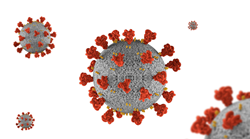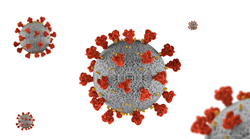
In a first for science, a team of researchers used wildtype SARS-CoV-2 to infect and replicate the disease on human tissue in an organ-on-a-chip device. Image: Shutterstock.
“The door is now open for using naturally circulating viruses to develop and screen therapies for COVID-19 using the best method available—organ-on-a-chip,” said Ashley Gard, Draper scientist and corresponding author for a research paper by Draper and Massachusetts General Hospital.
CAMBRIDGE, Mass. (PRWEB)
June 23, 2021
A new Draper-led study has demonstrated the first SARS-CoV-2 infection and viral replication using a wildtype virus in a human tissue lung-on-a-chip. The findings, posted as a preprint article on bioRxiv, represent a breakthrough in SARS-CoV-2 research and a promising path forward for therapy development.
“In SARS-CoV-2 research, organ-on-chip is emerging as a powerful method for scientists to assess the potential effects of drugs in humans. In this research, we advance the science with the first successful demonstration of SARS-CoV-2 infection in human primary airway epithelial cells derived from a living donor,” said Ashley Gard, the paper’s corresponding author and scientist at Draper. “The door is now open for using naturally circulating viruses to develop and screen therapies for COVID-19 using the best method available—organ-on-a-chip.”
This research collaborative, led by Gard, a senior member of the technical staff at Draper, includes experts in synthetic biology, molecular biology, cell and tissue engineering, molecular microbiology, biotechnology and biomedical engineering. The lung-on-a-chip at the heart of the study simulates the human lung’s own airway-liquid interface (ALI), an achievement that promises to give a boost to COVID-19 therapy development.
In the study, the researchers investigated viral infection kinetics of the SARS-CoV-2 virus in the PREDICT96-ALI platform in a BSL-3 laboratory environment. They measured RNA levels increasing 600-fold during the experiment, a validation of the model’s capacity to support SARS-CoV-2 viral infection and replication. They also detected the presence of large multi-cell clusters, further confirming SARS-CoV-2 replication and spread to neighboring cells.
The findings indicate a promising advance beyond the use of pseudoviruses in SARS-CoV-2 research studies. Compared to a naturally occurring virus, pseudoviruses contain only fragments of host-cell DNA without containing any of the nucleic acid components of the infectious virus to which they are related. The lack of DNA prevents the pseudoviruses from producing viral surface proteins on their own. Results with naturally occurring, or wildtype, virus are more relevant to the infection and replication process that causes disease in humans.
The paper advances the case for ALI tissue models by identifying additional applications, including chronic pulmonary conditions, acute respiratory infections and toxic exposures to the lung. But it also describes the limitations of traditional membrane insert-based systems, such as challenges with high resolution imaging, large media volumes and a lack of dynamic media circulation and real-time sensing, all of which highlight the advantages of this high throughput organ-on-chip approach.
Co-author Benjamin Medoff, MD, Chief of Pulmonary and Critical Care at Massachusetts General Hospital, said, “This study offers a detailed description of how the airway-on-a-chip model can be used to evaluate mechanisms of infection for the SARS-CoV-2 virus. The demonstration of PREDICT96-ALI for use in high-throughput assays is quite important and highlights its utility in drug discovery and therapeutic screening applications.”
Co-author Jeff Borenstein added, “PREDICT96-ALI has the demonstrated capacity for use in high-throughput assays, a critical capability for practical drug discovery and therapeutic screening applications. Leveraging all of its features, this model will facilitate high-throughput, preclinical evaluation of therapeutic candidates in a dynamic tissue microenvironment that supports real-time, non-invasive sensing and imaging.”
Gard added that one reason researchers have been unable to demonstrate SARS-CoV-2 infection and replication in human tissue models in organ-on-chip systems is that most systems are configured as laboratory research tools, and operation in the BSL-3 environment requires an instrumented well plate designed to fit pharmaceutical industry standard tools. “Preparing for a pandemic requires tools that rapidly integrate with pharma infrastructure and are instrumented for the remote monitoring and operation necessary to operate in a BSL-3 environment. Draper’s tool fits that description,” Gard said.
Co-authors from Draper include Christine Fisher, Felix Mba Medie, Rebeccah Luu, Robert Gaibler, Caitlin Miller, Thomas Mulhern, Vidhya Vijayakumar, Elizabeth Marr, Jeffrey Borenstein and Ashley Gard. Co-authors from MGH include Jehan Alladina and Benjamin Medoff.
Draper has contributed to organ-on-chip programs for a number of government agencies, academic institutions and commercial customers.
Draper
At Draper, we believe exciting things happen when new capabilities are imagined and created. Whether formulating a concept and developing each component to achieve a field-ready prototype or combining existing technologies in new ways, Draper engineers apply multidisciplinary approaches that deliver new capabilities to customers. As a nonprofit engineering innovation company, Draper focuses on the design, development and deployment of advanced technological solutions for the world’s most challenging and important problems. We provide engineering solutions directly to government, industry and academia; work on teams as prime contractor or subcontractor; and participate as a collaborator in consortia. We provide unbiased assessments of technology or systems designed or recommended by other organizations—custom designed, as well as commercial-off-the-shelf. http://www.draper.com
Share article on social media or email:

